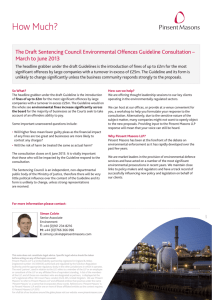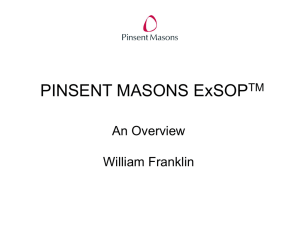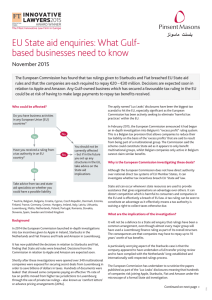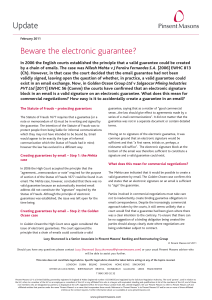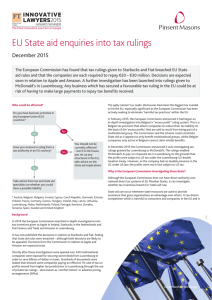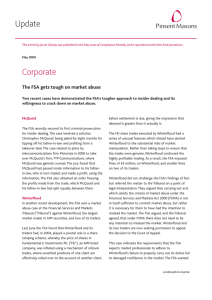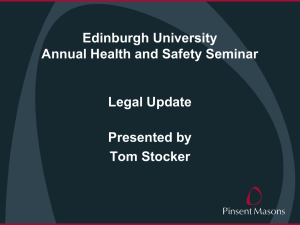LG -Accidents at School- Apr 09:1.qxd
advertisement
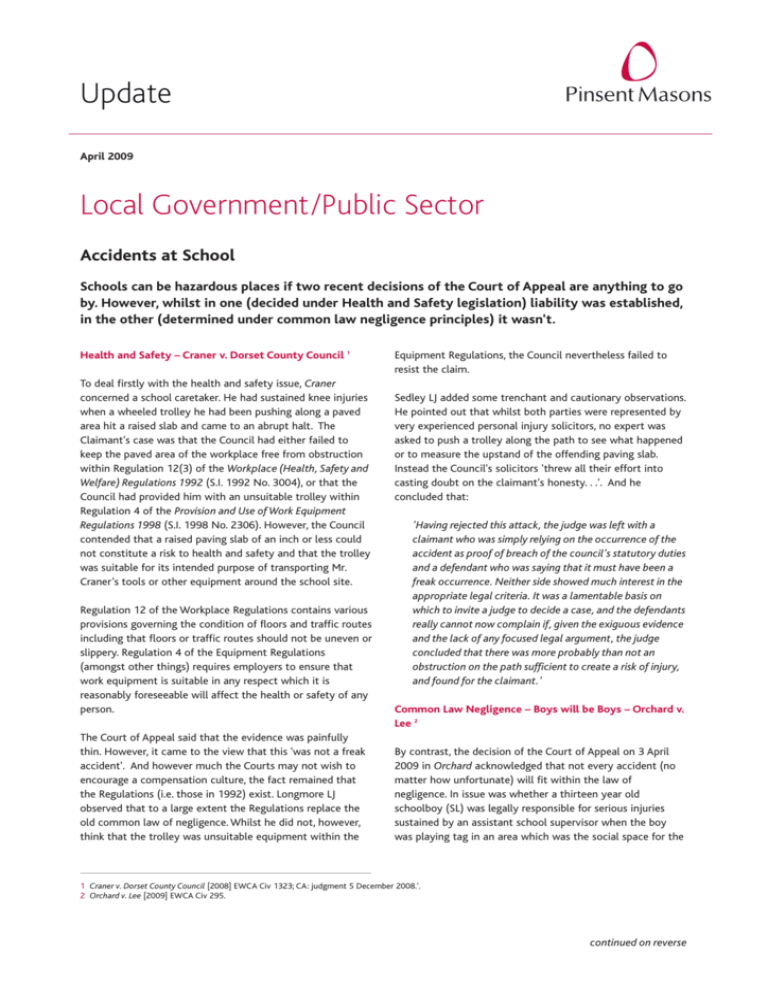
Update April 2009 Local Government/Public Sector Accidents at School Schools can be hazardous places if two recent decisions of the Court of Appeal are anything to go by. However, whilst in one (decided under Health and Safety legislation) liability was established, in the other (determined under common law negligence principles) it wasn't. Health and Safety – Craner v. Dorset County Council 1 To deal firstly with the health and safety issue, Craner concerned a school caretaker. He had sustained knee injuries when a wheeled trolley he had been pushing along a paved area hit a raised slab and came to an abrupt halt. The Claimant's case was that the Council had either failed to keep the paved area of the workplace free from obstruction within Regulation 12(3) of the Workplace (Health, Safety and Welfare) Regulations 1992 (S.I. 1992 No. 3004), or that the Council had provided him with an unsuitable trolley within Regulation 4 of the Provision and Use of Work Equipment Regulations 1998 (S.I. 1998 No. 2306). However, the Council contended that a raised paving slab of an inch or less could not constitute a risk to health and safety and that the trolley was suitable for its intended purpose of transporting Mr. Craner's tools or other equipment around the school site. Regulation 12 of the Workplace Regulations contains various provisions governing the condition of floors and traffic routes including that floors or traffic routes should not be uneven or slippery. Regulation 4 of the Equipment Regulations (amongst other things) requires employers to ensure that work equipment is suitable in any respect which it is reasonably foreseeable will affect the health or safety of any person. The Court of Appeal said that the evidence was painfully thin. However, it came to the view that this 'was not a freak accident'. And however much the Courts may not wish to encourage a compensation culture, the fact remained that the Regulations (i.e. those in 1992) exist. Longmore LJ observed that to a large extent the Regulations replace the old common law of negligence. Whilst he did not, however, think that the trolley was unsuitable equipment within the Equipment Regulations, the Council nevertheless failed to resist the claim. Sedley LJ added some trenchant and cautionary observations. He pointed out that whilst both parties were represented by very experienced personal injury solicitors, no expert was asked to push a trolley along the path to see what happened or to measure the upstand of the offending paving slab. Instead the Council's solicitors 'threw all their effort into casting doubt on the claimant's honesty. . .'. And he concluded that: 'Having rejected this attack, the judge was left with a claimant who was simply relying on the occurrence of the accident as proof of breach of the council's statutory duties and a defendant who was saying that it must have been a freak occurrence. Neither side showed much interest in the appropriate legal criteria. It was a lamentable basis on which to invite a judge to decide a case, and the defendants really cannot now complain if, given the exiguous evidence and the lack of any focused legal argument, the judge concluded that there was more probably than not an obstruction on the path sufficient to create a risk of injury, and found for the claimant.' Common Law Negligence – Boys will be Boys – Orchard v. Lee 2 By contrast, the decision of the Court of Appeal on 3 April 2009 in Orchard acknowledged that not every accident (no matter how unfortunate) will fit within the law of negligence. In issue was whether a thirteen year old schoolboy (SL) was legally responsible for serious injuries sustained by an assistant school supervisor when the boy was playing tag in an area which was the social space for the 1 Craner v. Dorset County Council [2008] EWCA Civ 1323; CA: judgment 5 December 2008.'. 2 Orchard v. Lee [2009] EWCA Civ 295. continued on reverse relevant age group. The judge at first instance (despite sympathy for the Appellant) found that this was a simple accident caused by 'horseplay between two 13 year old boys in and around an outside courtyard . . . boys doing what boys do'. The Court of Appeal agreed. Waller LJ said that the primary question should be whether the conduct of the child is culpable 'i.e. whether it has fallen below the standard that should objectively be expected of a child of that age.' And that '. . .will be assisted by what injury the child could foresee as likely to be caused by that conduct'. Furthermore: '. . .for a child to be held culpable the conduct must be careless to a very high degree and where a child of 13 is partaking in a game within a play area, not breaking any rules, and is not acting to any significant degree beyond the norms of that game, he or she will not be held culpable.' And whilst it was not in issue that the boy owed a duty of care: '. . .if there is to be found a breach of that duty of care it would have to be established that SL, a 13 year old, was running about and playing tag in a way which was to a significant degree outside the norm for 13 year olds. The answer to that question can be assisted by considering whether SL was conducting himself in the way he played tag in a manner in which a 13 year old boy would reasonably foresee there was likely to be injury beyond that normally occurring while a game of tag was in progress.' So Waller LJ agreed with the Judge at first instance that: '. . .13 year old boys will be 13 year old boys who will play tag. They will run backwards and they will taunt each other. If that is what they are doing and they are not breaking any rules they should not be held liable in negligence.' Aikens LJ (in referring to the speech of Lord Porter in Bolton v. Stone [1951] Ac 850 at 858) added that: 'Before holding that a person has acted negligently so as to be liable in an action for negligence, the court must be satisfied that a reasonable person in the position of the defendant (i.e. the person who caused the incident) would contemplate that injury is likely to follow from his acts or omissions. Nor is the remote possibility of injury enough; there must be a sufficient probability of injury to lead a reasonable person (in the position of the defendant) to anticipate it.' Conclusion Whilst statutory regulations governing areas previously covered by common law principles will often impose a much stricter standard of behaviour, clearly the Council's conduct of the case in Craner didn't assist its cause. For Sedley LJ pointed out, given the 'exiguous evidence' and 'lack of any focused argument' the Council cannot complain as to the outcome. And Orchard (despite the unfortunate consequences for the injured school supervisor) might be seen as another milestone in the line of authority that seeks to rehabilitate the concept of the accident and create a greater sense of proportion surrounding the compensation culture. Either way though, no-one – private sector organisation, public authority or individual - is relieved of the responsibility to take reasonable care of themselves and others and to comply with relevant law governing their behaviour and responsibilities. But for local authorities having to defend such a case, the moral of Craner is to make sure your lawyers have got their ducks properly in line. Nicholas Dobson Pinsent Masons April 2009 He considered that since parents and schools are there to control children, it would be a retrograde step to visit liability on a 13 year old for simply playing a game in the area where he was allowed to do so. © Pinsent Masons LLP 2009 Should you have any questions please contact Nicholas Dobson (nicholas.dobson@pinsentmasons.com) or your usual Pinsent Masons adviser who will be able to assist you further. This note does not constitute legal advice. Specific legal advice should be taken before acting on any of the topics covered. LONDON BIRMINGHAM BRISTOL LEEDS MANCHESTER EDINBURGH GLASGOW DUBAI BEIJING SHANGHAI HONG KONG T 0845 300 32 32 Pinsent Masons LLP is a limited liability partnership registered in England & Wales (registered number: OC333653) and regulated by the Solicitors Regulation Authority. The word ‘partner’, used in relation to the LLP, refers to a member of the LLP or an employee or consultant of the LLP or any affiliated firm who has equivalent standing and qualifications. A list of the members of the LLP, and of those nonmembers who are designated as partners, is displayed at the LLP’s registered office: CityPoint, One Ropemaker Street, London EC2Y 9AH, United Kingdom. We use ‘Pinsent Masons’ to refer to Pinsent Masons LLP and affiliated entities that practise under the name ‘Pinsent Masons’ or a name that incorporates those words. Reference to ‘Pinsent Masons’ is to Pinsent Masons LLP and/or one or more of those affiliated entities as the context requires. For important regulatory information please visit: www.pinsentmasons.com www.pinsentmasons.com
